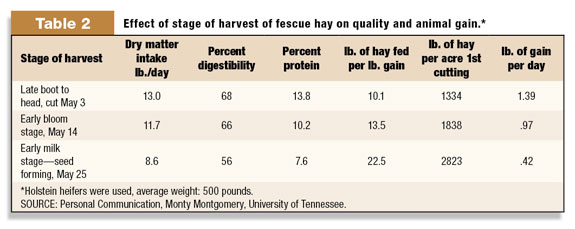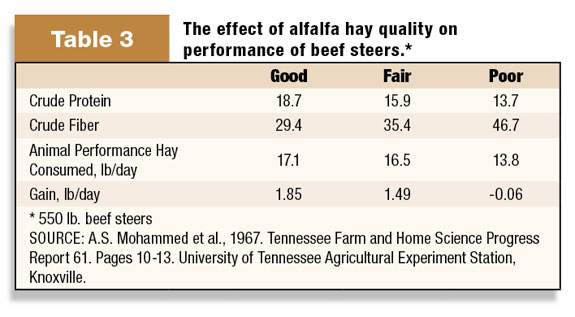
Hay is, therefore, the most commonly used stored feed on most farms.
Forage quality can be defined as the extent to which a forage has the potential to produce a desired animal response.
Factors that influence forage quality include the following:
• Palatability
Will the animals eat the forage? Animals select one forage over another based on smell, feel and taste.
Palatability may therefore be influenced by texture, leafiness, fertilization, dung or urine patches, moisture content, pest infestation or compounds that cause a forage to taste sweet, sour or salty.
High-quality forages are generally highly palatable.
• Intake
How much will they eat? Animals must consume adequate quantities of forage to perform well. Typically, the higher the palatability and forage quality, the higher the intake.
• Digestibility
How much of the forage will be digested? Digestibility (the extent to which forage is absorbed as it passes through an animal’s digestive tract) varies greatly.
Immature, leafy plant tissues may be 80 to 90 percent digested, while less than 50 percent of mature, stemmy material is digested.
• Nutrient content
Once digested, will the forage provide an adequate level of nutrients?
• Anti-quality factors
Various compounds may be present in forage that can lower animal performance, cause sickness or even result in death. Such compounds include tannins, nitrates, alkaloids, cyanoglycosides, estrogens and mycotoxins.
The presence or severity of these elements depend on the plant species present (including weeds), time of year, environmental conditions and animal sensitivity.
Animal performance is the ultimate test of forage quality. Forage quality encompasses “nutritive value” (the potential for supplying nutrients), how much animals will consume and any anti-quality factors present.
Animals’ performance can be influenced by any of several factors associated with either the plants or the animals.
Failure to give proper consideration to any of these factors may reduce an animal’s performance level, which in turn reduces potential income.
Of all the factors affecting hay quality, stage of maturity when harvested is the most important and the one in which greatest progress can be made.
As legumes and grasses advance from the vegetative to reproductive (seed) stage, they become higher in fiber and lignin content and lower in protein content, digestibility and acceptability to livestock.
The optimum stages of maturity to harvest for yield-quality-persistence compromise is usually when plants are making a transition from vegetative (leafy) to reproductive (flower-seed) stage.
Making the first hay cut early permits aftermath growth to begin at a time when temperature and soil moisture are usually more favorable for plant growth and generally increases total yield per acre.
Curing and handling conditions
After mowing, poor weather and handling conditions can lower hay quality. Rain can cause leaf loss and can leach nutrients from plants during curing.
Sunlight can lower hay quality through bleaching and lowering Vitamin A content. Raking or tedding dry, brittle hay can cause excessive leaf loss.
Hay plants with an 80 percent moisture content must lose approximately 6,000 pounds of water to produce a ton of hay at 20 percent moisture.
Crushing stems (conditioning) at time of mowing will cause stems to dry at more nearly the same rate as leaves. Conditioning will usually decrease the drying time of large-stemmed plants by up to a day and can result in leaf and nutrient savings.
Raking or tedding while hay is moist (about 40 percent moisture) and baling before hay is too dry (below 15 percent moisture) will help reduce leaf losses (see Table 1).
Our overall goal during the haymaking season should be to produce for yield, harvest for quality and market for profit. Throughout the process remember “save the leaves” and “control the controllable.” FG











